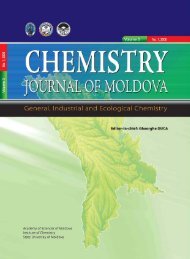stiinte med 1 2012.indd - Academia de ÅtiinÅ£e a Moldovei
stiinte med 1 2012.indd - Academia de ÅtiinÅ£e a Moldovei
stiinte med 1 2012.indd - Academia de ÅtiinÅ£e a Moldovei
Create successful ePaper yourself
Turn your PDF publications into a flip-book with our unique Google optimized e-Paper software.
36<br />
Buletinul AŞM<br />
A more difficult problem is to <strong>de</strong>termine how free<br />
radicals are involved in patients with thermal burns.<br />
The most studied effect of oxygen <strong>de</strong>rivates radicals<br />
is their involvement in oxidative <strong>de</strong>struction of polyunsaturated<br />
fatty acids, a phenomenon known as<br />
“lipid peroxidation”. Proteins are also subject to oxidative<br />
process un<strong>de</strong>r the action of O 2<br />
, H 2<br />
O, NO.<br />
Oxidative modifications of proteins varies <strong>de</strong>pending<br />
on the nature of oxidant and the protein studied.<br />
Through lipid peroxidation molecular stable products<br />
are generated, most important being toxic al<strong>de</strong>hy<strong>de</strong>s.<br />
This creates a basis for dissemination of toxigenic<br />
substances of lipid peroxidation. Last reacts with thiol<br />
groups of glutathione, cystine, protein, amino groups<br />
of some amino acids and inhibit enzymatic activity,<br />
having different effects on cells and organs, especially<br />
in the growing organism.<br />
Thus, the damage in the primary stage of burns,<br />
accompanied with major shock and sepsis focus on<br />
microcirculation and <strong>med</strong>ium molecular weight proteins<br />
activated to aggregate and adhere to the epithelium,<br />
releasing <strong>med</strong>iators that are able to <strong>de</strong>stroy<br />
microvascularization. In the late stages of combustional<br />
sepsis and septic shock macrophages are <strong>de</strong>stroyed,<br />
capable to secret over 100 different products that<br />
play a crucial role in triggering vicious circles leading<br />
to cellular-organic damage.<br />
Studies conclu<strong>de</strong> that free radicals, oxygen <strong>de</strong>rivatives<br />
are consi<strong>de</strong>red very important <strong>med</strong>iators of<br />
production of tissue damage after episo<strong>de</strong>s of ischemia<br />
(reperfusion and septic shock).<br />
Fundamental mechanism of free radicals generation<br />
in severe burns is the impairment of the blood<br />
flow and microcirculation, hypoxia, endogenous intoxication,<br />
infection, etc. In the acute phase of the thermal<br />
injury on the background of increased vascular<br />
permeability and the sequestration of plasma into the<br />
interstitial spaces, absolute and relative hypovolemia<br />
<strong>de</strong>velops, as well as the centralization of the blood<br />
circulation. The last has the adaptive role, supplying<br />
a<strong>de</strong>quate blood flow to the priority organs (brain,<br />
heart, lungs), but simultaneously leads to regional<br />
and peripheral blood circulation disor<strong>de</strong>r. The accentuation<br />
of the microcirculation disor<strong>de</strong>r is accompanied<br />
by tissue hypoxia, anaerobic glycolysis activation,<br />
formation of active forms of oxygen (AFO), which<br />
triggers free radical oxidation processes, with subsequent<br />
membrane damage and cell <strong>de</strong>ath as a consequence.<br />
Such oxidative reactions, leading to the<br />
formation of toxic metabolites, inclu<strong>de</strong> the oxidation<br />
of lipid products, which in time are neutralized by<br />
the body’s antioxidant system. An important role in<br />
triggering oxidative stress plays the microbial factor.<br />
Massive release into the blood stream of the microbial<br />
lipopolysachari<strong>de</strong>s lead to the activation of neutrophils<br />
and macrophages, formation of active forms<br />
of oxygen and its activation [3].<br />
Thus in the pathogenesis of thermal burns an<br />
important place have processes induced by free radicals.<br />
Tissues un<strong>de</strong>r the thermal action are a powerful<br />
source of free radicals, triggering a multitu<strong>de</strong> of<br />
chain reactions of lipid peroxidation. The intensity of<br />
lipid peroxidation correlates with the severity of the<br />
patient’s condition and <strong>de</strong>pends on the severity of hypoxia,<br />
which <strong>de</strong>velops as a result of reduced ventilation<br />
and the microcirculation alteration [7, 5]. Lipid peroxidation<br />
products are highly toxic compounds and<br />
induce the mitochondria’s increase in volume, uncoupling<br />
the oxidative phosphorylation, inactivation of<br />
thiol enzymes involved in respiration and glycolysis,<br />
is disturbing the synthesis of a<strong>de</strong>nosine in cells, oxidation<br />
of sulfhydryl groups in proteins, damages the<br />
DNA, this could slow down or even stop cell division<br />
and growth, violating the permeability of biological<br />
membranes.<br />
Lysosomal membrane lipid peroxidation promotes<br />
the activation of lysosomal hydrolases, proteolytic<br />
enzymes [6]. The activation of the enzyme cleavage<br />
products, damage cells, with the formation of various<br />
toxic substances (molecules with high <strong>med</strong>ium and<br />
low molecular weight).<br />
It is confir<strong>med</strong> that oxidative stress in thermal<br />
trauma are based on the following: blood flow and<br />
microcirculation disturbance, hypoxia, endogenous<br />
intoxication, microbial spread and AFO hyperproduction,<br />
intensification of lipid peroxid oxidation (LPO)<br />
and the <strong>de</strong>velopment of oxidative stress antioxidant<br />
insufficiency. The use in severe burns of the antihypoxanth<br />
drugs with antioxidant and membrane stabilizing<br />
action, which would reduce the pathogenetic<br />
reactions [1, 2, 4].<br />
An important issue remains in the role of lipid<br />
peroxidation in children aged 0-5 years with thermal<br />
burns. A reasoned scientific approach is missing in the<br />
evaluation of oxidation of lipid peroxidation in the<br />
wound and the influence on these processes of therapeutic<br />
re<strong>med</strong>ies for the topical treatment and effective<br />
preparations used for the topical treatment of wounds<br />
in patients with burns and their consequences.<br />
The research objectives were:<br />
• Assess of the state of oxidation of lipid peroxidation<br />
in children with thermal burns, aged 0 to<br />
5 years;<br />
• To <strong>de</strong>termine the dynamic processes of lipid<br />
peroxidation in blood and wound <strong>de</strong>pending on lesion<br />
stage process in patients with burns.<br />
Materials and methods<br />
The work is perfor<strong>med</strong> in the IMSP SCRC “Em.

















